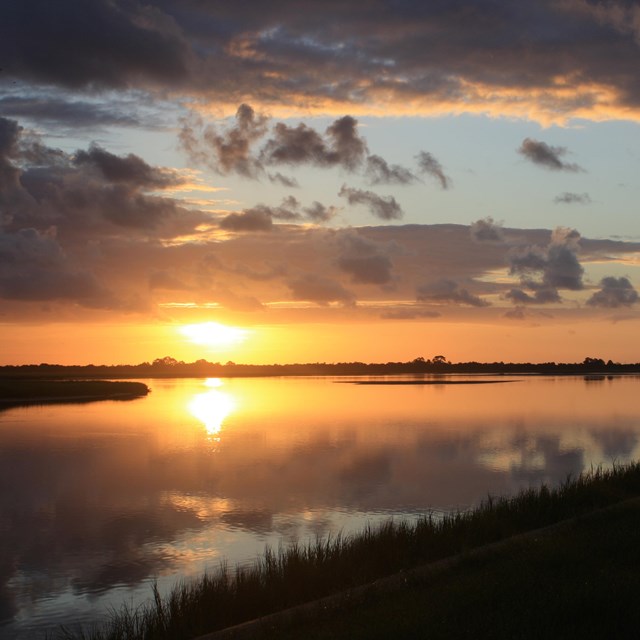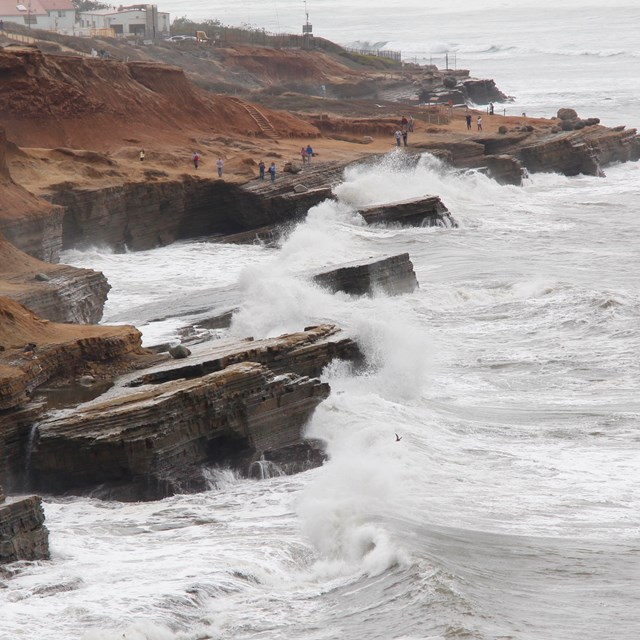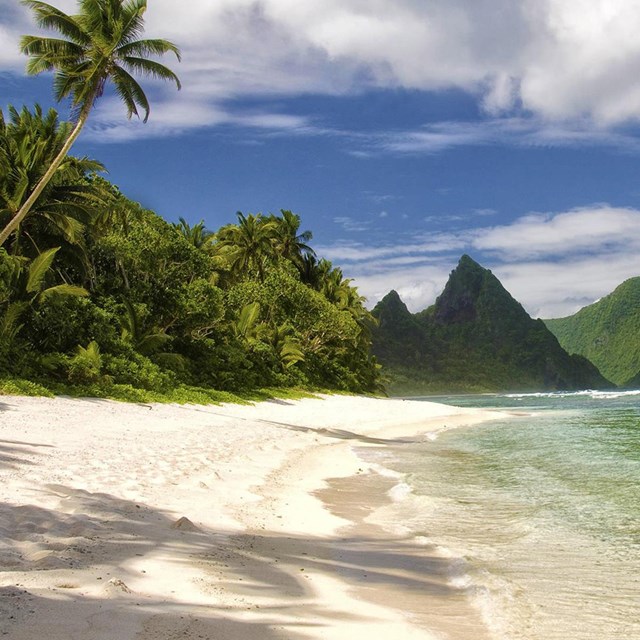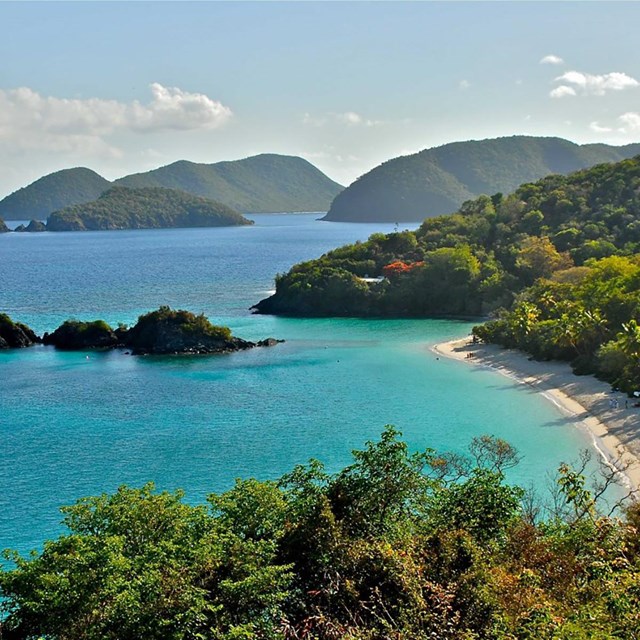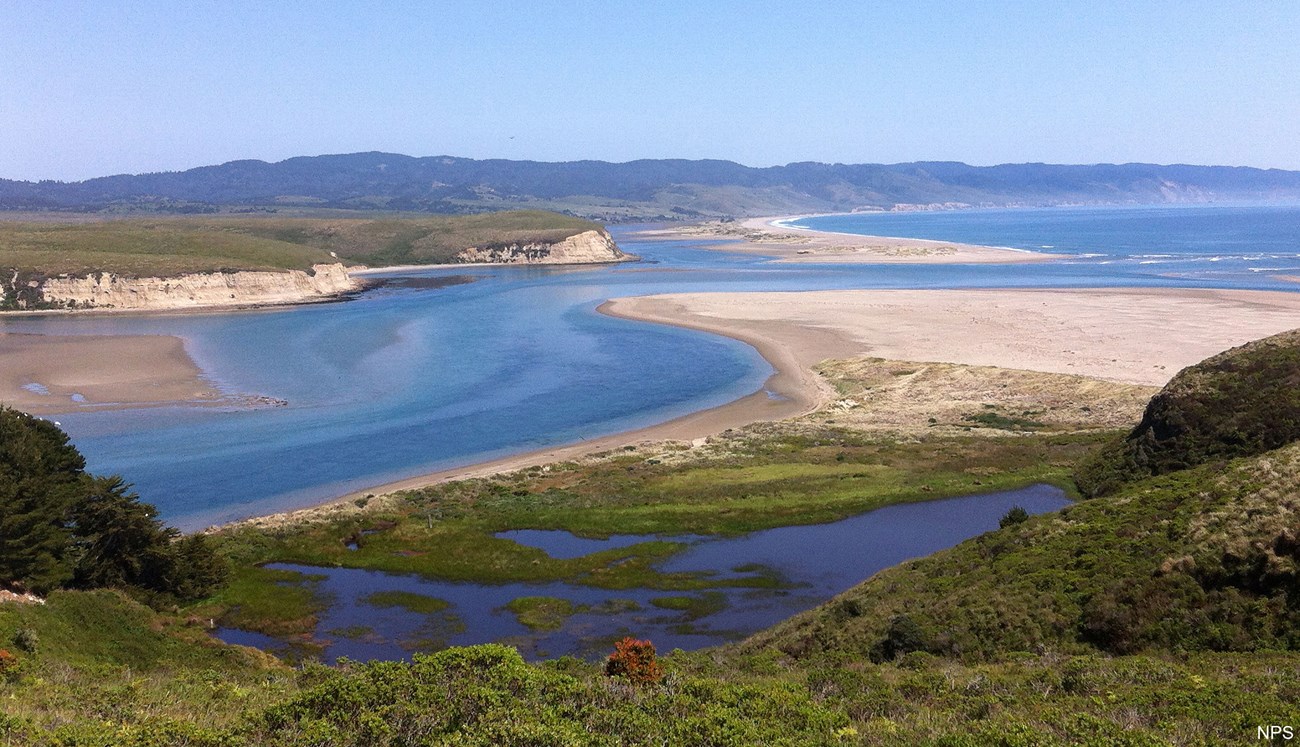
NPS Photo.
Introduction
Our national parks contain diverse coastal environments: high-energy rocky shorelines of Acadia National Park in Maine, quiet lagoons within War in the Pacific National Historical Park in Guam, and the white sandy beaches of Gulf Islands National Seashore in Mississippi and Florida.

In general, the coastal environment can be defined as that area lying at the interface between land and Oceans (or other large body of water). It includes both the zone of shallow water within which waves are able to move sediment, and the area landward of this zone, including beaches, cliffs, and coastal dunes, which is affected to some degree by the direct or indirect effects of waves, tides, and currents. The coastal environment itself may extend inland for many miles.
A variety of factors—including wave energy, tidal range, sediment supply, beach materials, continental-shelf slope and width, and past geologic history (e.g., glaciation, volcanism, and plate movement)—characterize coastal environments.
The coastal zone is one of the most dynamic regions on earth. Think of it, 70% of our planet is covered in water possessing enormous energy!
Coastal Erosion and Deposition
Shorelines can be generally divided into two types, high relief erosional shorelines and low relief depositional shorelines.
Coastal processes create many erosional or depositional features we see when visiting the National Parks such as:
- Beach Ridges
Beach ridges are wave deposited sand ridges running parallel to shoreline. - Wave-Cut Scarps
A wave-cut scarp is a steep bank created by wave erosion. - Marine Terraces
A marine terrace is a raised beach or 'perched coastline' that has been raised out of the reach of wave activity.
Coastal Landform Types
Over time, the interaction of coastal processes and an area's geologic setting leads to the development of characteristic and dramatic coastal landforms. See the articles below for an introduction to some of the coastal landforms present in parks:
Coastal Landforms in Parks
Click sections below for park examples
- Acadia National Park, Maine—[Geodiversity Atlas] [Park Home]
- Amistad National Recreation Area, Texas—[Geodiversity Atlas] [Park Home]
- Aniakchak National Monument and Preserve, Alaska—[Geodiversity Atlas] [Park Home]
- Assateague Island National Seashore, Maryland, Virginia—[Geodiversity Atlas] [Park Home]
- Bering Land Bridge National Preserve, Alaska—[Geodiversity Atlas] [Park Home]
- Big Cypress National Preserve, Florida—[Geodiversity Atlas] [Park Home]
- Biscayne National Park, Florida—[Geodiversity Atlas] [Park Home]
- Boston National Historic Park, Massachusetts—[Geodiversity Atlas] [Park Home]
- Boston Harbor Islands National Recreation Area, Massachusetts—[Geodiversity Atlas] [Park Home]
- Buck Island Reef National Monument, Virgin Islands—[Geodiversity Atlas] [Park Home]
- Cabrillo National Monument, California—[Geodiversity Atlas] [Park Home]
- Canaveral National Seashore, Florida—[Geodiversity Atlas] [Park Home]
- Cape Cod National Seashore, Massachusetts—[Geodiversity Atlas] [Park Home]
- Cape Hatteras National Seashore, North Carolina—[Geodiversity Atlas] [Park Home]
- Cape Krusenstern National Monument, Alaska—[Geodiversity Atlas] [Park Home]
- Cape Lookout National Seashore, North Carolina—[Geodiversity Atlas] [Park Home]
- Castillo de San Marcos National Monument, Florida—[Geodiversity Atlas] [Park Home]
- Castle Clinton National Memorial, New York—[Geodiversity Atlas] [Park Home]
- Channel Islands National Park, California—[Geodiversity Atlas] [Park Home]
- Colonial National Historic Park, Virginia—[Geodiversity Atlas] [Park Home]
- Cumberland Island National Seashore, Georgia—[Geodiversity Atlas] [Park Home]
- De Soto National Memorial, Florida—[Geodiversity Atlas] [Park Home]
- Dry Tortugas National Park, Florida—[Geodiversity Atlas] [Park Home]
- Everglades National Park, Florida—[Geodiversity Atlas] [Park Home]
- Fire Island National Seashore, New York—[Geodiversity Atlas] [Park Home]
- Fort Caroline National Memorial, Florida—[Geodiversity Atlas] [Park Home]
- Fort Frederica National Monument, Georgia—[Geodiversity Atlas] [Park Home]
- Fort Matanzas National Monument, Flordia—[Geodiversity Atlas] [Park Home]
- Fort McHenry National Monument and Historic Shrine, Maryland—[Geodiversity Atlas] [Park Home]
- Fort Moultrie National Monument, South Carolina—[Geodiversity Atlas] [Park Home]
- Fort Point National Historic Site, California—[Geodiversity Atlas] [Park Home]
- Fort Pulaski National Monument, Georgia—[Geodiversity Atlas] [Park Home]
- Fort Raleigh National Historic Site, North Carolina—[Geodiversity Atlas] [Park Home]
- Fort Sumter National Monument, South Carolina—[Geodiversity Atlas] [Park Home]
- Gateway National Recreation Area, New Jersey and New York—[Geodiversity Atlas] [Park Home]
- Glacier Bay National Park and Preserve, Alaska—[Geodiversity Atlas] [Park Home]
- Golden Gate National Recreation Area, California—[Geodiversity Atlas] [Park Home]
- Governors Island National Monument, New York—[Geodiversity Atlas] [Park Home]
- Gulf Islands National Seashore, Mississippi and Florida—[Geodiversity Atlas] [Park Home]
- Haleakalā National Park, Hawaii—[Geodiversity Atlas] [Park Home]
- Hawaii Volcanoes National Park, Hawaii—[Geodiversity Atlas] [Park Home]
- Jean Lafitte National Historical Park and Preserve, Louisiana—[Geodiversity Atlas] [Park Home]
- Kalaupapa National Historical Park, Hawaii—[Geodiversity Atlas] [Park Home]
- Kaloko Honokohau National Historical Park, Hawaii—[Geodiversity Atlas] [Park Home]
- Katmai National Park and Preserve, Alaska—[Geodiversity Atlas] [Park Home]
- Kenai Fjords National Park, Alaska—[Geodiversity Atlas] [Park Home]
- Klondike Gold Rush National Historical Park, Alaska—[Geodiversity Atlas] [Park Home]
- Lake Clark National Park and Preserve, Alaska—[Geodiversity Atlas] [Park Home]
- Lewis and Clark National Park, Oregon and Washington—[Geodiversity Atlas] [Park Home]
- National Park of the American Samoa, American Samoa—[Geodiversity Atlas] [Park Home]
- New Bedford Whaling National Historic Park, Massachusetts—[Geodiversity Atlas] [Park Home]
- Olympic National Park, Washington—[Geodiversity Atlas] [Park Home]
- Padre Island National Seashore, Texas—[Geodiversity Atlas] [Park Home]
- Point Reyes National Seashore, California—[Geodiversity Atlas] [Park Home]
- Pu'uhonua O Honaunau National Historical Park, Hawaii—[Geodiversity Atlas] [Park Home]
- Pu'ukohola Heiau National Historic Site, Hawaii—[Geodiversity Atlas] [Park Home]
- Redwood National Park, California—[Geodiversity Atlas] [Park Home]
- Roosevelt Campobello International Park, Maine—[Geodiversity Atlas] [Park Home]
- Sagamore Hill National Historic Site, New York—[Geodiversity Atlas] [Park Home]
- Saint-Gaudens National Historic Site, New Hampshire—[Geodiversity Atlas] [Park Home]
- Saint Croix International Historic Site, Maine—[Geodiversity Atlas] [Park Home]
- Salem Maritime National Historic Site, Massachusetts—[Geodiversity Atlas] [Park Home]
- Salt River Bay National Historic Park and Ecological Preserve, Virgin Islands—[Geodiversity Atlas] [Park Home]
- San Juan National Historic Site, Puerto Rico—[Geodiversity Atlas] [Park Home]
- Santa Monica Mountains National Recreation Area, California—[Geodiversity Atlas] [Park Home]
- Sitka National Historical Park, Alaska—[Geodiversity Atlas] [Park Home]
- Statue of Liberty National Memorial, New York—[Geodiversity Atlas] [Park Home]
- Timucuan Ecological and Historic Preserve, Florida—[Geodiversity Atlas] [Park Home]
- Virgin Islands National Park, Virgin Islands—[Geodiversity Atlas] [Park Home]
- Virgin Islands Coral Reef National Monument, Virgin Islands—[Geodiversity Atlas] [Park Home]
- War in the Pacific National Historical Park, Guam—[Geodiversity Atlas] [Park Home]
- World War II Valor in the Pacific National Monument, Hawaii—[Geodiversity Atlas] [Park Home]
- Wrangell-St. Elias National Park and Preserve, Alaska—[Geodiversity Atlas] [Park Home]
- Wright Brothers National Memorial, North Carolina—[Geodiversity Atlas] [Park Home]
- Ebey's Landing National Historical Reserve, Washington—[Geodiversity Atlas] [Park Home]
- George Washington Birthplace National Monument, Virginia—[Geodiversity Atlas] [Park Home]
- Governors Island National Monument, New York—[Geodiversity Atlas] [Park Home]
- Klondike Gold Rush National Historical Park, Alaska—[Geodiversity Atlas] [Park Home]
- Port Chicago Naval Magazine National Memorial, California—[Geodiversity Atlas] [Park Home]
- San Francisco Maritime National Historical Park, California—[Geodiversity Atlas] [Park Home]
- San Juan Island National Historical Park, Washington—[Geodiversity Atlas] [Park Home]
- Thomas Stone National Historic Site, Maryland—[Geodiversity Atlas] [Park Home]
- Apostle Islands National Lakeshore, Wisconsin—[Geodiversity Atlas] [Park Home]
- Crater Lake National Park, Oregon—[Geodiversity Atlas] [Park Home]
- Indiana Dunes National Lakeshore, Indiana—[Geodiversity Atlas] [Park Home]
- Isle Royale National Park, Michigan—[Geodiversity Atlas] [Park Home]
- Perry's Victory and International Peace Memorial National Memorial, Ohio—[Geodiversity Atlas] [Park Home]
- Pictured Rocks National Lakeshore, Michigan—[Geodiversity Atlas] [Park Home]
- Sleeping Bear Dunes National Lakeshore, Michigan—[Geodiversity Atlas] [Park Home]
- Voyaguers National Park, Minnesota—[Geodiversity Atlas] [Park Home]
- Whiskeytown National Recreation Area, California—[Geodiversity Atlas] [Park Home]
- Yellowstone National Park, Idaho, Wyoming, and Montana—[Geodiversity Atlas] [Park Home]
- Yosemite National Park, California—[Geodiversity Atlas] [Park Home]
- Bighorn Canyon National Recreation Area, Montana and Wyoming—[Geodiversity Atlas] [Park Home]
- Chickasaw National Recreation Area, Oklahoma—[Geodiversity Atlas] [Park Home]
- Curecanti National Recreation Area, Colorado—[Geodiversity Atlas] [Park Home]
- Glen Canyon National Recreation Area, Utah—[Geodiversity Atlas] [Park Home]
- Lake Chelan National Recreation Area, Washington—[Geodiversity Atlas] [Park Home]
- Lake Mead National Recreation Area, Nevada—[Geodiversity Atlas] [Park Home]
- Lake Meredith National Recreation Area, Texas—[Geodiversity Atlas] [Park Home]
- Lake Roosevelt National Recreation Area, Washington—[Geodiversity Atlas] [Park Home]
- Ross Lake National Recreation Area, Washington—[Geodiversity Atlas] [Park Home]
Photo Gallery
Geological Monitoring
Related Links
Last updated: August 16, 2023


